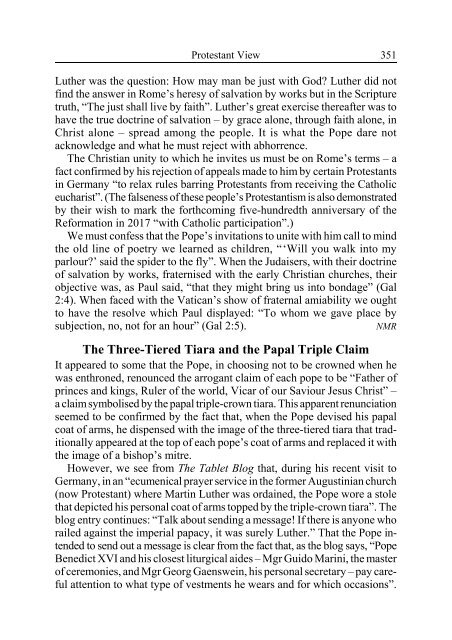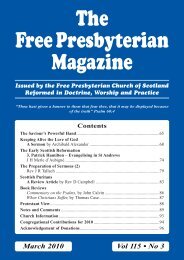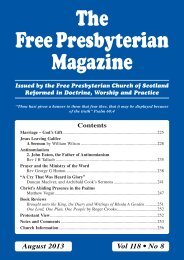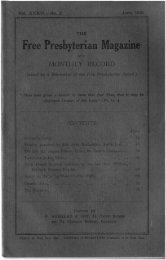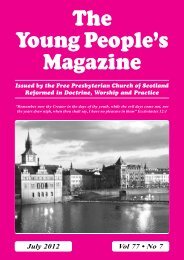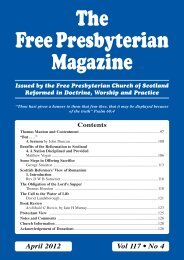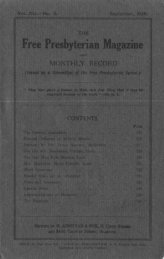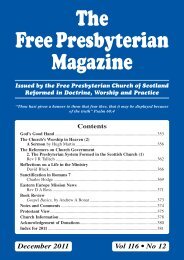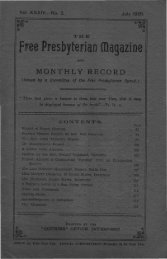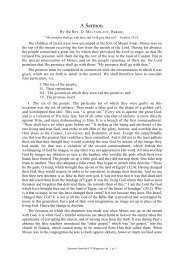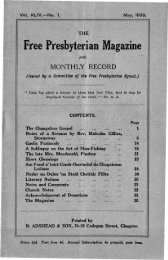The Free Presbyterian Magazine - Free Presbyterian Church of ...
The Free Presbyterian Magazine - Free Presbyterian Church of ...
The Free Presbyterian Magazine - Free Presbyterian Church of ...
You also want an ePaper? Increase the reach of your titles
YUMPU automatically turns print PDFs into web optimized ePapers that Google loves.
Protestant View 351<br />
Luther was the question: How may man be just with God? Luther did not<br />
find the answer in Rome’s heresy <strong>of</strong> salvation by works but in the Scripture<br />
truth, “<strong>The</strong> just shall live by faith”. Luther’s great exercise thereafter was to<br />
have the true doctrine <strong>of</strong> salvation – by grace alone, through faith alone, in<br />
Christ alone – spread among the people. It is what the Pope dare not<br />
acknowledge and what he must reject with abhorrence.<br />
<strong>The</strong> Christian unity to which he invites us must be on Rome’s terms – a<br />
fact confirmed by his rejection <strong>of</strong> appeals made to him by certain Protestants<br />
in Germany “to relax rules barring Protestants from receiving the Catholic<br />
eucharist”. (<strong>The</strong> falseness <strong>of</strong> these people’s Protestantism is also demonstrated<br />
by their wish to mark the forthcoming five-hundredth anniversary <strong>of</strong> the<br />
Reformation in 2017 “with Catholic participation”.)<br />
We must confess that the Pope’s invitations to unite with him call to mind<br />
the old line <strong>of</strong> poetry we learned as children, “‘Will you walk into my<br />
parlour?’ said the spider to the fly”. When the Judaisers, with their doctrine<br />
<strong>of</strong> salvation by works, fraternised with the early Christian churches, their<br />
objective was, as Paul said, “that they might bring us into bondage” (Gal<br />
2:4). When faced with the Vatican’s show <strong>of</strong> fraternal amiability we ought<br />
to have the resolve which Paul displayed: “To whom we gave place by<br />
subjection, no, not for an hour” (Gal 2:5). NMR<br />
<strong>The</strong> Three-Tiered Tiara and the Papal Triple Claim<br />
It appeared to some that the Pope, in choosing not to be crowned when he<br />
was enthroned, renounced the arrogant claim <strong>of</strong> each pope to be “Father <strong>of</strong><br />
princes and kings, Ruler <strong>of</strong> the world, Vicar <strong>of</strong> our Saviour Jesus Christ” –<br />
a claim symbolised by the papal triple-crown tiara. This apparent renunciation<br />
seemed to be confirmed by the fact that, when the Pope devised his papal<br />
coat <strong>of</strong> arms, he dispensed with the image <strong>of</strong> the three-tiered tiara that traditionally<br />
appeared at the top <strong>of</strong> each pope’s coat <strong>of</strong> arms and replaced it with<br />
the image <strong>of</strong> a bishop’s mitre.<br />
However, we see from <strong>The</strong> Tablet Blog that, during his recent visit to<br />
Germany, in an “ecumenical prayer service in the former Augustinian church<br />
(now Protestant) where Martin Luther was ordained, the Pope wore a stole<br />
that depicted his personal coat <strong>of</strong> arms topped by the triple-crown tiara”. <strong>The</strong><br />
blog entry continues: “Talk about sending a message! If there is anyone who<br />
railed against the imperial papacy, it was surely Luther.” That the Pope intended<br />
to send out a message is clear from the fact that, as the blog says, “Pope<br />
Benedict XVI and his closest liturgical aides – Mgr Guido Marini, the master<br />
<strong>of</strong> ceremonies, and Mgr Georg Gaenswein, his personal secretary – pay careful<br />
attention to what type <strong>of</strong> vestments he wears and for which occasions”.


